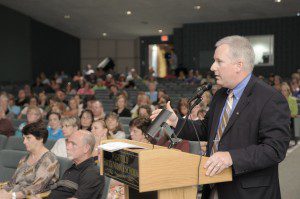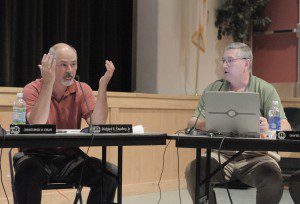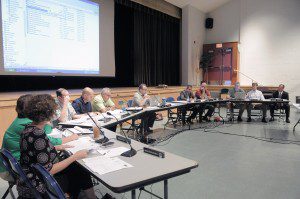
Westfield Mayor Daniel Knapik, right, defends his proposed FY2014 city budget during last nights City Council special meeting staged in the Westfield Middle School South auditorium. The budget passed as proposed. (Photo by Frederick Gore)
WESTFIELD – The City Council rejected the $1.5 million in budget cuts proposed by the Finance Committee and voted 7-5 last night to accept the 2014 fiscal year budget as submitted last month by Mayor Daniel M. Knapik.
That vote came at the end of a 75-minute discussion in the South Middle School auditorium filled with city officials, employees and residents. The debate included several heated exchanges between Knapik and At-large Councilor David A. Flaherty, a member of the Finance Committee, then later between Flaherty and At-large Councilor Brent B. Bean II.
Finance Chairman Richard E. Onofrey Jr., who conducted the budget workshop meeting, was forced to use the gavel several times to restore order.
Onofrey also explained the philosophy of the Finance Committee in recommending the $1.5 million in cuts, including the fact that the $117,265,366 budget was about $391,000 in the red.
Onofrey noted that in past years there would have been a proposed transfer from the stabilization fund to balance that deficit, but that transfer was not posted as part of the 2014 budget.
The Finance Committee has proposed $600,000 in “targeted cuts” to eliminate one-time, non-recurring expenditures which could have been covered with free cash or stabilization account funding.
Onofrey said the 1.25 percent across-the-board cuts, which totaled about $900,000, including an additional $685,000 cut from the School Department, were proposed to preserve long-term debt as the city prepares to sell a number of bonds for major infrastructure projects.
Flaherty requested that Knapik be allowed to make a statement and answer questions from council members.

Westfield City Councilor Brian Sullivan, left, lashes out at City Councilor David Flaherty, right, during last nights special City Council meeting to discuss the FY2014 city budget. Sullivan appeared upset over past events that were brought up which allegedly did not pertain to last night’s budget meeting. (Photo by Frederick Gore)
Knapik said that the 2013 budget was $775,000 in the red when it went into effect without a vote of the City Council and that deficit was reconciled when the council set the tax rate last November.
Knapik also said that $1 million in the free cash account will be transferred into the stabilization account before the end of the current fiscal year and that the goal is to have between $7 and $8 million in stabilization funding.
Knapik said that the numbers used for the budget process are moving targets until the city’s books are closed on June 30 and all accounts reconciled by the city auditor.
“Every week the budget numbers change,” Knapik said. “Any time I deliver a budget it is for a very (narrow) snapshot in time.”
The level of state aid to the city is also a moving target as the state House and Senate move to adopt a state budget.
“State aid is coming back slower that anybody predicted,” Knapik said. “It is still $3 to $4 million lower than it was in 2007 and 2008. We don’t have the final state numbers yet. Like every mayor I’m hopeful that the Senate and House pass a budget that is favorable to cities and towns.”
Knapik and Flaherty sparred about revenue and expense projections, as well as municipal finance practices, in particular contract negotiations and the liabilities of other post-employment benefits (OPEB) and health insurance, which Flaherty argued are underfunded in the present and future budgets.
Knapik responded that the OPEB and insurance are set by the state and the city’s retirement board, which manages those programs.
Bean requested the floor and addressed Flaherty directly.
“My point is you’re asking questions you think you have the answers to already,” Bean said, “I have a big problem with that. That’s playing politics. If you don’t like the budget vote ‘no’.”

Approximately 150 citizens gathered at the Westfield Middle School South auditorium last night during a special meeting of the Westfield City Council held to discuss the FY2014 city budget. (Photo by Frederick Gore)
At-large Councilor John J. Beltrandi III, also a Finance Committee number, asked Knapik about the deficit in the proposed budget.
“I need you to tell me you have the money for that $391,000,” Beltrandi said. “I don’t want to see people laid off.”
Knapik said that the city is positioned to use stabilization or free cash to balance the budget when the council sets the tax rate.
“So what I’m hearing is that we don’t have to cut $1.2 million because that money is in stabilization,” Beltrandi said. “I hope you can keep your promise.”
“This is the silly season (because the budget number is just projections until all of the pieces are put into place),” Knapik said, “I’m completely comfortable with this budget.”
Onofrey prepared to review the budget and vote on each Finance Committee cut, which involves 800 line items, when Beltrandi cut the knot with one motion.
“I’ve heard that this (deficit) has been done in the past and that the city has the revenue to take care of that shortfall,” Beltrandi said. “I make a motion to accept the budget as presented. We’ve been told that we have the money, that we don’t have to do this” cutting on 800 line items.
Ward 4 Councilor Mary O’Connell said that the council has an obligation to examine the budget in detail.
“This is our responsibility to go through the budget,” O’Connell said.
“If we’ve solved the problem, why beat it up?” Beltrandi responded.
Ward 6 Councilor Christopher Crean, a former Finance Committee member, said that last year the city used $800,000 from the stabilization account to balance the city’s books.
“I think the mayor has presented a decent budget,” Crean said. “I don’t see anything wrong with it. We’ve cut for several years now and the departments are down to bare bones. We have the money in stabilization, which is what it’s there for.”
Flaherty said that the city’s debt capacity, which is down to $5.5 million in the budget, needs to be around $7 million.
“I wish I had the stabilization numbers going into this process, but after all is said and done, I will second Councilor Beltrandi’s motion,” Flaherty said.
Voting “YES” to adopt the budget were Councilors James R. Adams, Bean, Beltrandi, Ann Callahan, Crean, Kevin Harraghy, and Brian Sullivan.
Voting “NO” were Councilors Flaherty, O’Connell, Onofrey, Agma Sweeney and Brian Winters.
The City Council will meet tonight to transfer $1,083,497 from free cash into the stabilization account and make the formal vote to approve “Orders of Appropriation for the Fiscal Year 2014 Budget.”


